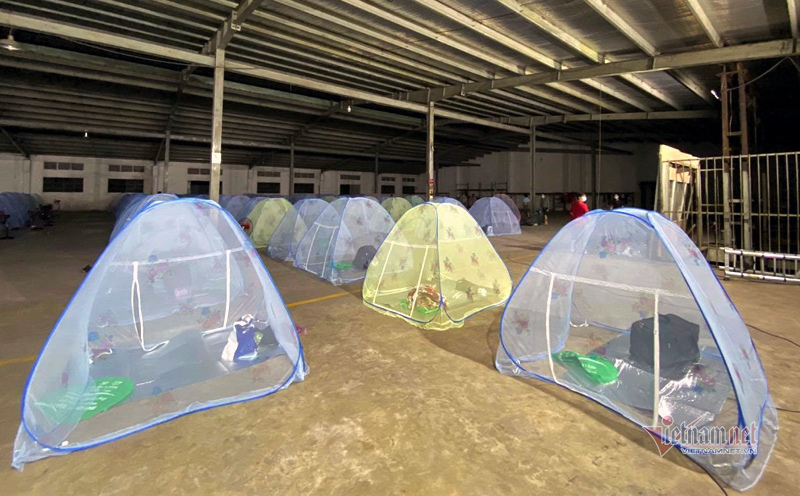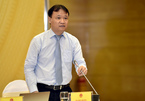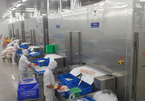
Enterprises organize production in accordance with the three on-the-site principle – working, eating and resting on the site.
Three on-the-site solution
Enterprises organize production in accordance with the three on-the-site principle – working, eating and resting on the site.
The solution is suitable for enterprises of small and medium scale. However, enterprises will have to spend a lot to compensate workers, because they have to stay at the same place for a long time.
Not all businesses in the city have sufficient human and material conditions to meet the "3 on-site" requirements required by the HCM City authorities to maintain operations.
This is the solution which has the lowest risk for virus spread.
Three on-the-site according to working shift
Enterprises organize production and isolation of workers on the site in rotation, according to production shifts.
There would be at least two production shifts in rotation, with 50 percent of workers for each shift. Workers, after a certain number of working days, will have a rest and they will be replaced by the other shift.
All members of production shifts must test negative before joining the production process and before returning to their accommodations. Enterprises will determine the time for working and resting.
Companies will have to regularly test workers after every production shift and have a solution to control workers at their accommodations.
The solution allows enterprises to reduce allowances to be provided to workers who follow the ‘three on the site’ regime.
This is believed to be a solution with medium risk.
The ‘one route, two places’ solution
Only one route would be used to carry workers from their accommodations (dorms, hotels, concentrated houses for workers) to workplaces. Enterprises have to organize the transportation of workers between the two points.
With this solution, workers are not allowed to use their private vehicles and must not leave the concentrated accommodations.
Workers have to be tested every week and positive cases will be put under quarantine, and contacts will be traced.
Enterprises will have to find accommodations large enough for their workforce.
If implementing this solution, enterprises will be able to save money and time compared with the ‘three on the site’ solution.
This plan has medium risk.
The expanded ‘one route, two places’ solution
Enterprises have to organize concentrated accommodations in many locations, and organize the transport of workers from many different accommodations to the workplace.
Workers are not allowed to use private vehicles and cannot leave the concentrated accommodations. Enterprises will have to supervise the accommodations.
Workers have to be tested every week and positive cases will be put under quarantine, and contacts will be traced.
With the solution, enterprises can also cut the allowances for workers. Workers can return to accommodations after work. It improves productivity and is better for mental health.
This solution has a risk at a medium level.
Four green solution
The four green include green workers, green production areas, green accommodations and green routes.
Green workers mean that workers are vaccinated and test negative once every seven days.
Green production areas are areas where green workers strictly observe the 5k principle. Independent production areas are arranged to satisfy the requirements on pandemic prevention and control.
Green accommodations are residential quarters where green workers meet the requirements on pandemic prevention and control. All the people living together are vaccinated, have tested negative, and satisfy the requirements on ‘green zone’.
If the ‘green accommodations’ no longer meet the requirements on ‘green zone’, workers will have to report to the enterprises immediately for re-arrangement.
The green routes are where where green workers can travel with their private means of transport between the green production zone and green accommodations in accordance with green routes, without stopping or staying. They must not go into high-risk areas.
This is a complex solution and enterprises need to control workers to be sure they always strictly observe the rules on pandemic prevention and control after they return to accommodations.
The solution allows enterprises to save time and money, ensures production capacity and maintains the workforce. It is better for psychological health and improves productivity.
However, the solution has a relatively high risk level.
The combined solution
Enterprises can apply all the above mentioned solutions in a flexible way. During the implementation process, they will need to mobilize different resources to serve production. They also need to ensure the separation of production units and the circulation of workers to ensure safe production.
Enterprises have to register their production solutions with the appropriate agencies of the city for approval.
Quang Dinh

'Three on-the-site' model to be adjusted to maintain production in the south
Deputy Minister of Industry and Trade Do Thang Hai said the ‘three on-the-site’ is a good model, but southern provinces have found it difficult to implement.

'3 on-site' model runs into problems as virus spreads inside isolated facilities
Enterprises in HCM City and other southern provinces have shelled billions of dong to implement the "3 on-site" model for business continuity however production at these facilities is still at risk of disruption due to the pandemic.